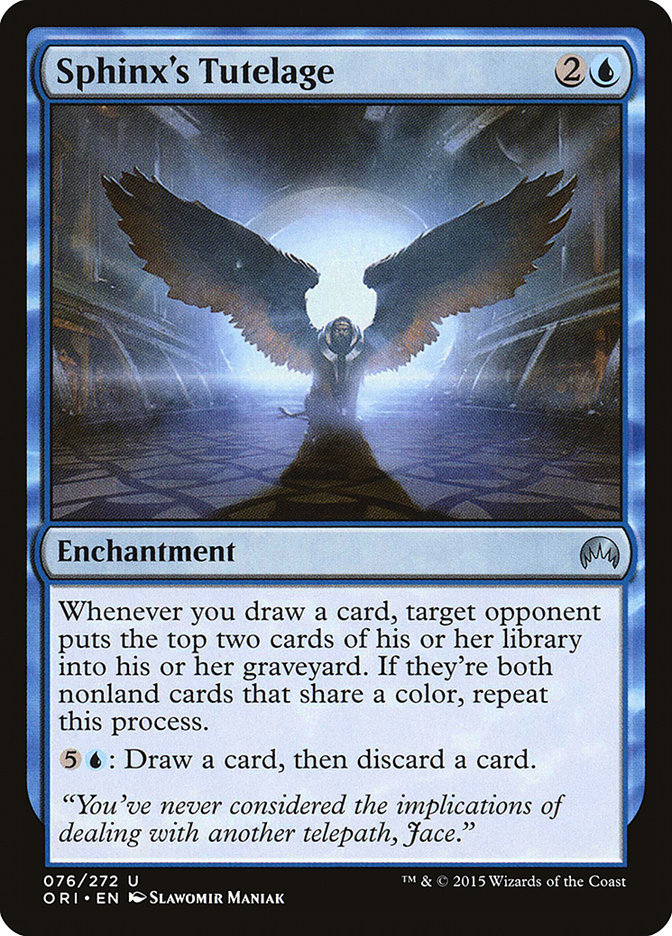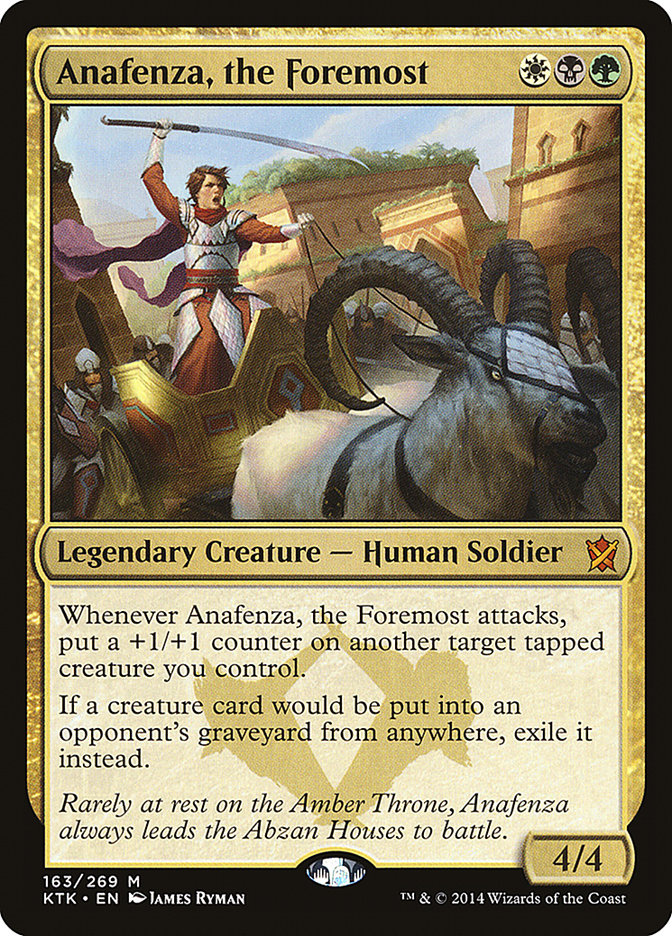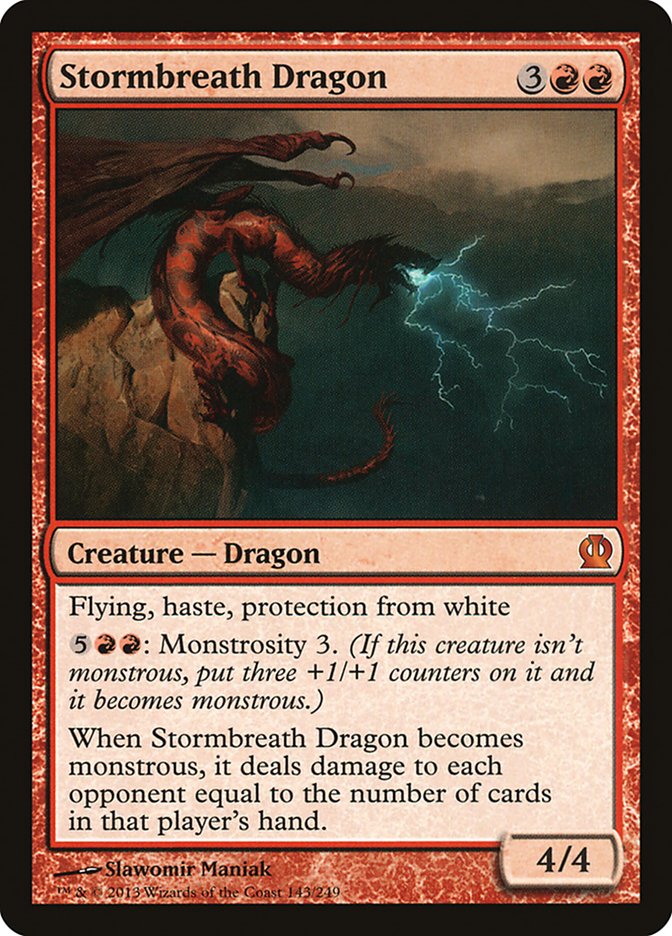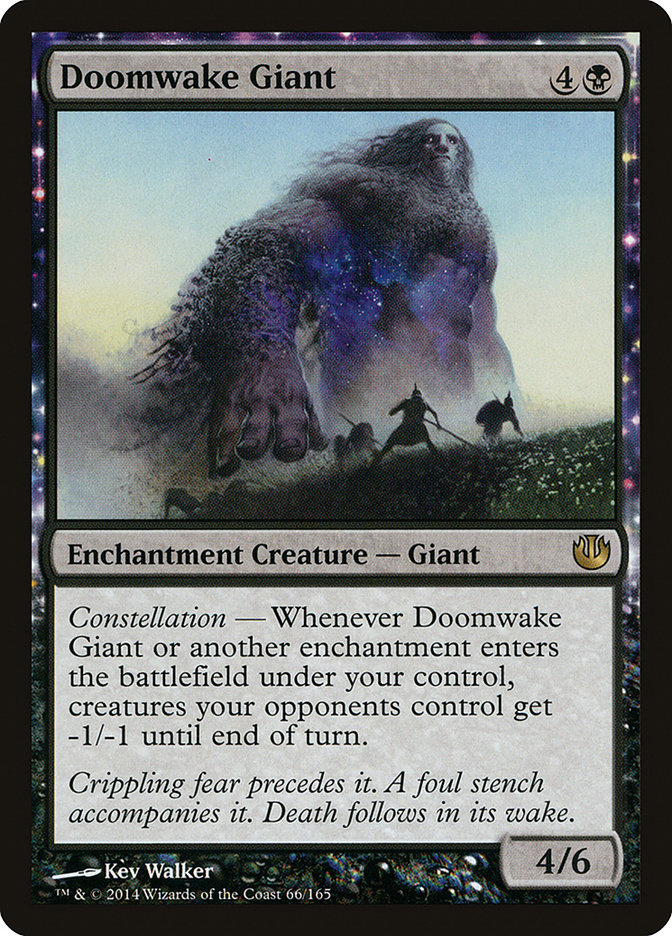There may have been a time when I had concerns that Magic Origins would collapse the amazingly-diverse Standard format we’ve grown accustomed to down to fewer decks, but that time has certainly passed. Abzan may remain “The Deck” in this format, as it’s debatably been all along, but it’s certainly among the less oppressive “Decks to Beat” that Magic has seen. It’s also fitting that, just as the metagame as a whole is more diverse and flexible than it’s often been, Abzan itself features far more branches and variations than other dominant decks historically have.
I think recent weeks have actually showed that there are now even more viable decks at the top than there were previously, a remarkable accomplishment given where we were previously. It’s particularly delightful that two of the most significant breakout decks have been U/R, the exact opposite of Abzan, referring of course to both Thopters and Sphinx’s Tutelage.
Creatures (4)
Lands (27)
Spells (29)
- 4 Anger of the Gods
- 2 Whelming Wave
- 4 Treasure Cruise
- 4 Tormenting Voice
- 1 Dig Through Time
- 1 Monastery Siege
- 2 Roast
- 4 Sphinx's Tutelage
- 2 Send to Sleep
- 1 Alhammarret's Archive
- 4 Magmatic Insight
Sideboard

Andrew Cuneo has been my favorite deck designer for a long time, and when I first heard about his deck for Pro Tour Magic Origins I thought it sounded awesome, but had no idea how good it was. I know Andrew put up a solid finish at the Pro Tour, but in talking to him he didn’t actually seem too excited about his deck. As such, I was happily surprised to learn that Michael Majors was undefeated with the deck after Day One.
Now that the deck has won a GP, people are going to have to take it seriously as a presence in this metagame, and frankly that just sounds weird to me. This is a really unusual deck to influence the metagame – it just doesn’t work like other decks. I guess it’s a control deck, in that it’s threat-light, answer-heavy and generally wins by having inevitability, but it doesn’t have any counterspells and it can’t really answer a wide variety of permanents. It’s kind of like Turbo-Fog. Outside of Anger of the Gods, it’s mostly relying on “answers” that just buy time – Send to Sleep and Whelming Wave – which are unusual cards to break into Constructed, and having a deck where they’re a major part of the game plan should have an unusual influence.
Mostly, what this deck does is draw cards. In that way, it feels more like a Modern or Legacy deck, and its finisher is an enchantment.
 I still haven’t played with or against this deck, but it’s clear that it’s actually a proactive, not reactive deck – it has few interactive elements and not a lot of ways to deal with the opponent’s cards, and the deck operates almost entirely at sorcery speed. It works because Sphinx’s Tutelage ends the game very quickly given how the deck is constructed, and most people don’t have many answers to Sphinx’s Tutelage.
I still haven’t played with or against this deck, but it’s clear that it’s actually a proactive, not reactive deck – it has few interactive elements and not a lot of ways to deal with the opponent’s cards, and the deck operates almost entirely at sorcery speed. It works because Sphinx’s Tutelage ends the game very quickly given how the deck is constructed, and most people don’t have many answers to Sphinx’s Tutelage.
This puts the deck in an interesting place where it leans heavily on a card that can very easily be answered if the opponent builds their deck to do that, but since the deck is full of card draw it’s easy to just draw into another copy of Sphinx’s Tutelage. This is particularly true because the presence of Ensoul Artifact on Darksteel Citadel specifically pushes people to go to Unravel the Aether as the Disenchant effect of choice, and Unraveling a Sphinx’s Tutelage won’t keep it away for very long. I think an important piece of the puzzle in beating this deck is to have good answers to Sphinx’s Tutelage, but I suspect that that should only work if the answers are supported by real pressure.
Ultimately, it’s a weird deck that serves as a very well-positioned counter to midrange decks built around board control and extracting value from trades, two-for-ones, and powerful planeswalkers. This deck is built to avoid the lines of interaction a deck like Abzan trumps and it wins by doing its own thing. In this way, the deck feels something like playing an Ichorid-based Dredge deck against a deck full of counterspells and creature removal. It looks like the opponent is ready to answer any kind of threat, but then you find a way to sidestep even the most well-rounded interaction and force a non-interactive game that you’re only too well-prepared to play.
So how do you beat this deck? Pressure, especially from creatures with more than three toughness, and enchantment removal looks like the most reliable plan. I bet Bant Heroic with Dromoka’s Command and access to Erase or Mortal Obstinacy would do very well. It also seems like Mono-Red Aggro should usually be able to race this deck effectively.
Of course, this GP wasn’t just about one deck and Standard isn’t just about one deck, and understanding where things are going involves looking at a much bigger picture.
As Patrick Chapin noted, Brian Kibler G/W deck took Standard by storm this weekend, and it looks like another deck that might be very well-positioned against Sphinx’s Tutelage. It’s surprising to me that Michael Majors managed to win the GP in a field with such a substantial G/W presence, and I wonder if the G/W deck as constructed is actually bad enough against Anger of the Gods to have an unfavorable matchup here. If it does, I think that’s something that could potentially be addressed with relatively few changes, like incorporating Brimaz, King of Oreskos and other efficient threats that live through Anger of the Gods.
Things are in an interesting place here — U/R Tutelage is great against Abzan Control, which is the most popular and, long term, likely the most successful deck. G/W Megamorph is weak against Abzan Control but good against a lot of the rest of the field, and I suspect that it can be built to beat U/R Tutelage much more easily than Abzan Control could be.
Given the rise of G/W Megamorph and Sphinx’s Tutelage, I agree with Patrick that a deck like Daniel Ward’s R/B dragons deck is remarkably well-positioned at the moment. Like Patrick I don’t generally like these decks much, but Stormbreath Dragon is great against G/W, and Dragons in general fit the theme of four toughness creatures with flying to dodge all the removal in the Sphinx’s Tutelage deck. Daniel did lose in three games to Michael Majors in the Top Eight, likely because he had no way to deal with Sphinx’s Tutelage, which makes me wonder if something like this or even possibly a Mardu version with access to Erase could be well-positioned here.
Continuing to look at the Top Eight, Artur Villela’s second-place Constellation deck is interesting, in that it doesn’t bother with Sigil of the Empty Throne and is instead basically built around Doomwake Giant. Doomwake Giant is, among other things, a fantastic answer to Thopters, but it is also just a card with a much more substantial immediate impact than Sigil of the Empty Throne. It also positions the deck very well against Elsepth, Sun’s Champion, a card that is poised to gain popularity because it’s so good against G/W Megamorph.
I really like this as a direction for Abzan Constellation. It has enough card advantage to go over the top of other midrange decks (read: Abzan Control) anyway, and really likes playing to an endgame that impacts the board a little faster and actually answers most things the opponent is doing. It might hurt a bit against certain control decks, as it leans more heavily on creatures, but the added strength Doomwake Giant offers against aggressive decks allows this build to use Brain Maggot instead of Nyx-Fleece Ram, which more than makes up for the cost in the change of five-drops, and the real plan against control is going to rely on sticking Starfield of Nyx anyway.
San Diego also saw the return of Esper Dragons, which I think was somewhat inevitable – it’s a powerful deck that was kept at bay early on by a fear of Languish but, as predicted, the format warped around Languish to the point where Languish lost stock as a major player and now the world looks safe for Dragonlord Ojutai again. Despite that, I’m still skeptical that things really look good for Esper Dragons at the moment. I think G/W Megamorph has the right aggressive tools to attack it – Esper Dragons is historically weak against Deathmist Raptor and Den Protector – and Sphinx’s Tutelage seems great against Esper Dragons as it just filters through its deck faster to find a cheaper, faster, and more reliable threat.
Another deck that found a resurgence in this moment when Languish it at a low point was Corey Burkhart’s Abzan Aggro deck. Corey told me about his deck early in the tournament, telling me that he was playing a version of Abzan Aggro that cut the three-mana removal for two-mana removal and had Herald of Torment. From that description, the deck sounded great to me. Abzan Aggro has generally been pretty good and I knew there wouldn’t be many copies of Languish to punish it, but my problem with the deck was that, like Abzan Control, it’s very bad at making two plays in one turn. Shifting to two-mana removal lets you get out of that restriction while also positioning the deck much better against the fast decks that did well at Pro Tour Magic Origins.
 Anafenza, the Foremost is really well-positioned as an answer to Deathmist Raptor, a hard-hitting threat that lives through Anger of the Gods, and a foil to decks like Abzan Rally, so playing a deck that really takes advantage of Anafenza makes a lot of sense. I also really like Corey’s access to three Sorin, Solemn Visitors. In the wake of a Pro Tour victory for Mono-Red Aggro, having more four-drops that can suddenly send the game out of red’s reach is exactly what I’d want. I also love that Corey doesn’t have maindeck Thoughtseize, a card I always try to leave in my sideboard.
Anafenza, the Foremost is really well-positioned as an answer to Deathmist Raptor, a hard-hitting threat that lives through Anger of the Gods, and a foil to decks like Abzan Rally, so playing a deck that really takes advantage of Anafenza makes a lot of sense. I also really like Corey’s access to three Sorin, Solemn Visitors. In the wake of a Pro Tour victory for Mono-Red Aggro, having more four-drops that can suddenly send the game out of red’s reach is exactly what I’d want. I also love that Corey doesn’t have maindeck Thoughtseize, a card I always try to leave in my sideboard.
I’m actually writing this immediately before playing in my first Standard Super League tonight, and I’ll be playing with a very slightly tweaked version of Corey’s deck because I didn’t really have time to try things out after the Grand Prix and I like the look of it.
I suppose that kind of speaks to the bigger question of where we go from here. Specifically, I think it says I don’t have an answer. Things are changing. Leading up to the Pro Tour, G/R Devotion may have been the deck to beat; at the Pro Tour, probably Burn and U/R Thopters. All of those decks were played in San Diego, and none of them made the Top Eight. It’s easy to build a narrative around a small sample size like the Top Eight of a Grand Prix and to totally miss the mark because of all the little things that go into a particular person narrowly making it or narrowly missing, but there’s a bigger picture of conversion rates that point to general success of a deck, and as Patrick showed on Monday, all of those decks did poorly at Grand Prix San Diego.
People were ready. I played Mono-Red Aggro at the Pro Tour because I believed that people who didn’t play it would have the wrong sideboard cards against me because they’d prepare for the wrong kind of red decks. I played it again in San Diego mostly because I was lazy. Despite that, I felt like I lost more because my draws were bad than because people were particularly prepared, which might actually speak to the significance of the mulligan rule for the red deck as a successful metagame choice, as it’s felt to me like my results correlate much more strongly with how successful I am at drawing between three and five lands over the course of the first five turns than what deck I’m playing against or how many sideboard cards they have.
I expect Standard to remain as it has been: a diverse format that rewards properly anticipating the exact point the metagame is at any given moment, or finding a new way to attack the format that people won’t be prepared for. The format may have some “best decks” that consistently perform well, but even with those it’s the person who has the exact right tweaks and the right list that succeeds with them. Having seen the inner workings of Patrick Chapin, Paul Rietzl, and Matt Sperling on Team UltraPro before seeing Matt Top Eight the Pro Tour and Paul Top Eight the Grand Prix, it certainly feels like it’s not a coincidence. Not just any Abzan deck can win, that success come from careful tuning.
Your best bets, if you’re trying to learn to win at Standard this season, are to either choose a versatile deck like Abzan and play it constantly, always reevaluating each of your cards and making sure they’re pulling their weight so that your list is up to date, or to just play a wide variety of matches and learn about the format on the level of individual cards and interactions so that, when it becomes clear what’s going to be popular, you know what decks have the tools to attack that thing.



